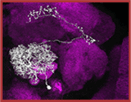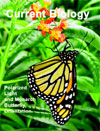The Monarch Project |
|
Goal: To develop the migratory monarch butterfly as a model for elucidating the cellular and molecular basis of time-compensated sun compass orientation.
Projects:
- Reconstruct the monarch circadian clock in vitro with cloned clock genes.
- Define the circadian clock circuitry in vivo.
- Delineate light input pathways.
- Determine the molecular and cellular basis of clock-compass interactions.
- Use genetic approaches to mark and delete clock neurons.
- Clarify the role of the circadian clock in the photoperiodically-induced migratory state.
- Establish an Expressed Sequence Tag database.
- Initiate transcriptional profiling of nonmigratory and migratory butterflies.
- Model a four-dimensional clock.
- Sequence and annotate the monarch butterfly genome.
Contact: steven.reppert@umassmed.edu
Publications:
Merlin C, Gegear RJ, Reppert SM (2009). Antennal Circadian Clocks Coordinate Sun Compass Orientation in Migratory Monarch Butterflies. Science 325: 1700-1704.
Zhu H, Gegear RJ, Casselman A, Kanginakudru S, Reppert SM (2009). Defining behavioral and molecular differences between summer and migratory monarch butterflies. BMC Biol 7:14.
Gegear RJ, Casselman A, Waddell S, Reppert SM. (2008). Cryptochrome mediates light-dependent magnetosensitivity in Drosophila. Nature 454: 1014-1018.
Zhu H, Sauman I, Yuan Q, Casselman A, Emery-Le M, Emery P, Reppert SM (2008). Cryptochromes define a novel circadian clock mechanism in monarch butterflies that may underlie sun compass navigation. PLoS Biol. 6:e4.
Zhu H, Casselman A, Reppert SM (2008). Chasing migration genes: A brain expressed sequence tag resource for summer and migratory butterflies (Danaus plexippus). PLoS ONE 3:e1345.
Reppert SM (2007). The ancestral circadian clock of moarch butterflies: Role in time-compensated sun compass orientation. Cold Spring Harb. Symp. Quant. Biol. 72:113-118.
Song S-H, Ozturk N, Denaro TR, Arat NO, Kao Y-T, Zhu H, Zhong D, Reppert SM, Sancar A (2007). Formation and function of flavin anion radical in cryptochrome 1 blue-light photoreceptor of monarch butterfly. J. Biol. Chem. 282:17608-17612.
Yuan Q, Metterville D, Briscoe AD, Reppert SM (2007). Insect cryptochromes: Gene duplication and loss define diverse ways to construct insect circadian clocks. Mol. Biol. Evol. 24:948-955.
Reppert, S.M. (2006). A colorful model of the circadian clock. Cell 124:233-236.
Zhu H, Yuan Q, Briscoe AD, Froy O, Casselman A, Reppert SM (2005). The two CRYs of the butterfly. Curr. Biol. 15:R953-R954.
Sauman, I., Briscoe, A.D., Zhu, H., Shi, D., Froy, O., Stalleichen, J., Yuan, Q., Casselman, A., Reppert, S.M. (2005). Connecting the navigational clock to sun compass input in monarch butterfly brain. Neuron 46:457-467.
Reppert, S.M., Zhu, H., White, R. (2004). Polarized light help monarch butterflies navigate. Curr. Biol. 14: 155-158.
Froy O, Gotter AL, Casselman AL, Reppert SM. (2003). Illuminating the circadian clock in monarch butterfly migration. Science 300:1303-1305.


